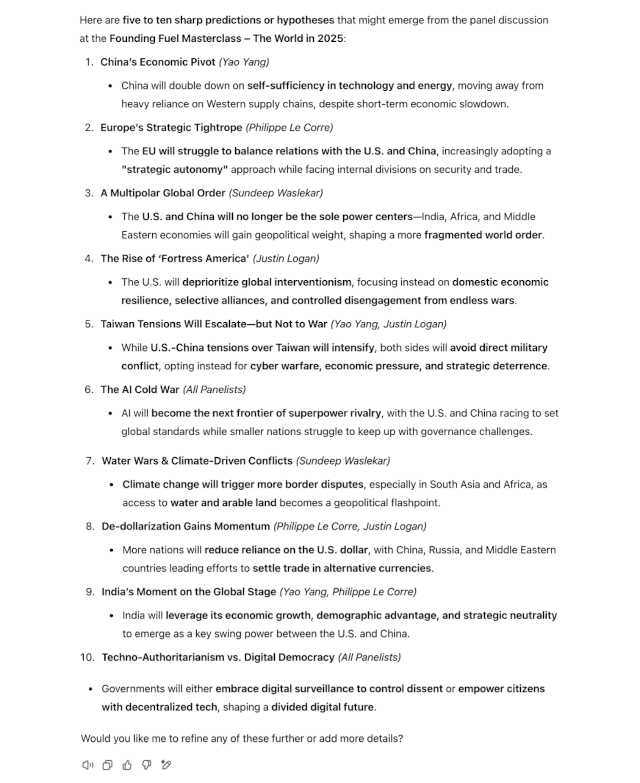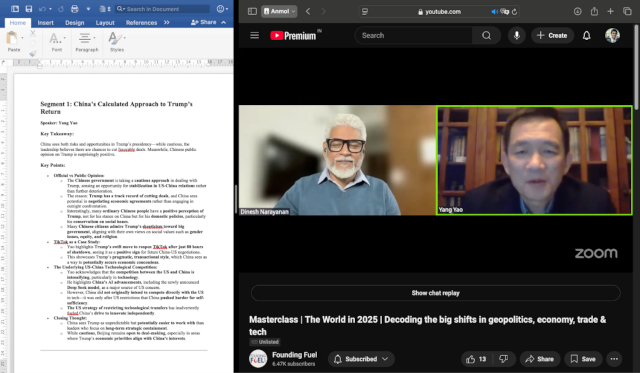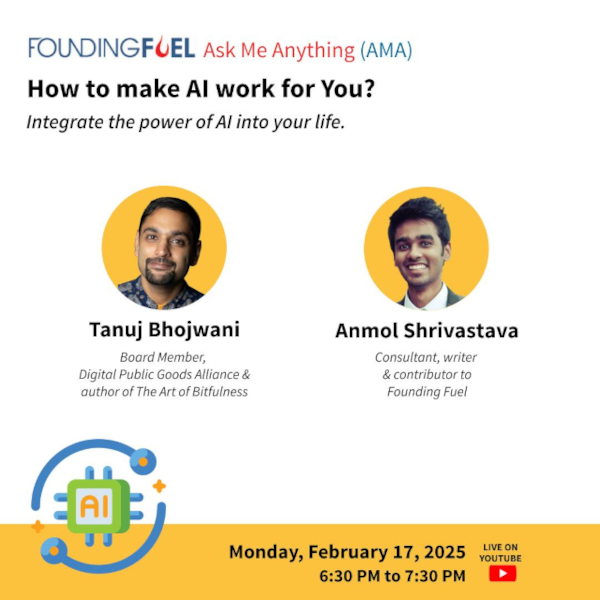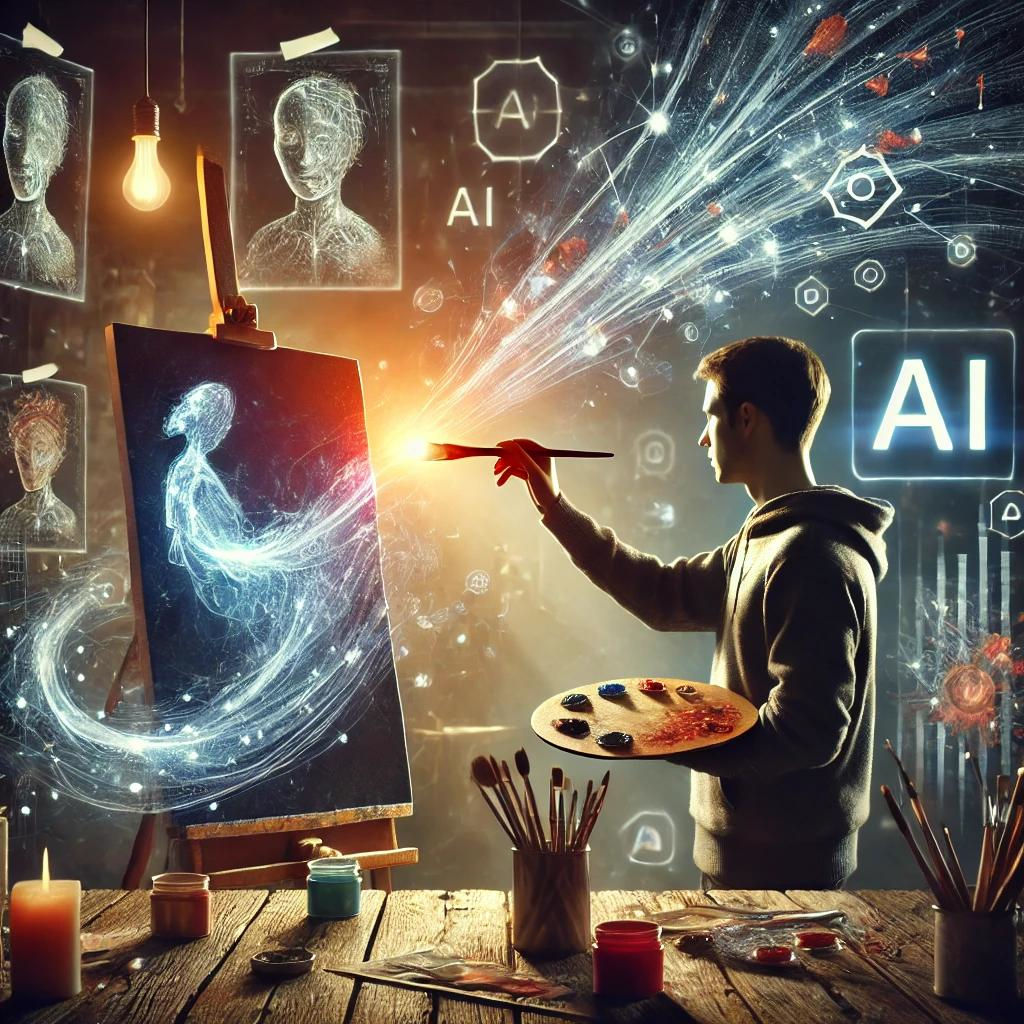Look, I know that for the past few weeks conversations around AI models, ChatGPT, DeepSeek, Deep Research, yada yada yada…have been on steroids. Your WhatsApp and Twitter feed is full of hot takes, opinions and news.
I am in fact worried that you may be so overwhelmed, fatigued or bored with anything remotely on AI, that you may just close this window and move ahead.
But hey, hang on! This one’s different.
Something interesting happened last Friday in the Founding Fuel community and I want to quickly share that with you. I am sure you will find it valuable and fun if you are someone who is yet to meaningfully integrate the power of AI into your life and everyday tasks (which let us be honest, would be most of us!)
So what happened last Friday?
Last Friday evening, Founding Fuel held the first session of its two-part Masterclass series on The World in 2025. Originally, I had planned to watch the recording as I had a business meeting scheduled at the same time. But then a last-minute cancellation made it possible for me to attend the live session.
The challenge was everything unfolded at 6:10 PM, five minutes before I was to join the Zoom call with all the panellists backstage. I didn’t even know their names, backgrounds, or the themes they may be discussing. I had missed the three pre-read briefings too.
Despite that, I was eager to dive in — especially with the excitement around Trump 2.0 and the AI and Chip War heating up.
To get up to speed, I asked ChatGPT to quickly review the event page and tell me a bit about the Masterclass, the panellists and the format. While ChatGPT gave me a decent intro about the panellists, it was standard boilerplate stuff — their names, designation and a one-line bio. It didn’t really capture the vibe of the event or provide enough context for me to confidently walk into the session and engage with the panellists.
What I needed was more akin to what I was so used to doing in my first job at Samhita as the Executive Assistant to the CEO Priya Naik. When Priya was on a panel, I used to often brief her about who the other panellists were, what they were likely to say and analyse their perspectives. This helped her craft responses that could stand out and pack a punch.
At this moment, I needed AI to step into that same role — to be my Executive Assistant, providing me with the depth and context I needed as I prepared to enter the (digital) room with the panellists.
So, I asked ChatGPT to do something a little different: I asked it to predict 5-10 sharp insights about what each panellist might say, based on their past work and public comments.
Here’s what it predicted.

(AI’s view prior to the Masterclass on 5-10 sharp predictions or hypothesis that might emerge from the panel discussion based on the past-work and public comments)
This was much more interesting, and I felt far better prepared.
Now, the Masterclass kicked-off. Let me confess, my attention often wanders during these video/audio formats. I am more of a reader than a listener. When I listen, I prefer 1.25x or 1.5x as it helps keep the attention intact. But this is not possible during a live session.
Back in school or office, when I missed something, I could just tap a friend or colleague and ask them to recap. On Zoom, whose shoulder do I tap?
It turns out, on Zoom there’s now a feature called ‘AI Companion’, which works much like ChatGPT. You just type ‘Catch Me Up’, and voila, you’re caught up on what you missed.
Here’s a quick GIF of how it works.
(A visual example of ‘Catch me Up’ feature of Zoom AI companion in action)
I have been using Google Meet for the past year, so I was unaware about this feature until the Masterclass. Throughout the session, especially during transitions from one panellist to another, I used this feature. It gave me a recap of what had transpired and helped me relax, knowing I wasn’t missing out on key points.
On a few occasions, I even experimented with new prompts, asking it to suggest follow-up questions based on the discussion. Next time, I plan to use it not just for catch-up, but for even more experiments. This tool has so much potential!
Once the Masterclass wrapped up, I was still buzzing with ideas.
I wasn’t satisfied with just a standard Executive Assistant briefing or a quick tap-on-the-shoulder recap from a friend. I wanted to feel Presidential. I’ve always been fascinated by how the POTUS receives daily intelligence briefings from the CIA and FBI Director. Imagine having an entourage of world-class experts shaping your thinking on every topic.

(Barack Obama, POTUS, 2008-2016, being briefed by his entourage of experts. Photo via Wikimedia)
So, I decided to give ChatGPT a challenge.
I uploaded the transcript of the Masterclass (thanks to my colleague Ram, who kindly provided the Zoom transcript) and asked ChatGPT to prepare a strategic summary as if I were the President receiving a briefing on a major event — complete with insights from the panellists, predictions on their positions, and any key takeaways or strategic implication for our country.
At first, the summaries ChatGPT provided were too high-level and abstract — they didn’t quite have the colour and context I was hoping for. But after adjusting my request to ask for a segment-by-segment summary, the results started to improve. You can check out the final conversation here, along with the initial attempts that didn’t quite hit the mark for me personally.
With the summary in hand, I didn’t stop there. I kept pushing ChatGPT with questions like:
- Based on their comments, what could you infer about the personality traits of each panellist?
- How accurate were your predictions about their views before the session? What did you get right, and what did you miss?
- What unexpected themes emerged that you hadn’t predicted?
- If you had more time with these panellists, what new questions would you ask them?
- Who was your favourite panellist, and who would you hesitate to debate?
- Were there moments of heated debates? How could the panellists have strengthened their arguments?
Here’s a presentation with the highlights
After diving deep into these questions, I watched the entire Masterclass again — this time with the segment-by-segment summary on one side of the screen and the YouTube recap on the other.

(Rewatching the Masterclass with the segment by segment summary on the side)
This second round of watching helped me internalise the signals better. It also revealed something surprising: AI had hallucinated certain details that didn’t actually happen during the Masterclass, such as a supposed discussion about the US-China conflict over Taiwan (which, in reality, wasn’t mentioned at all).
I watched the Masterclass again and took the time to identify and correct these hallucinations as far as possible. I also brought it to the notice of ChatGPT and asked it to be mindful and correct its work. It was a good reminder that while AI is incredibly powerful, it's not perfect — and its outputs require a discerning eye. (To dive deeper into this phenomenon of hallucination, read here.)
You can view the final AI-generated summary with reduced hallucinations here. And a complete hand-crafted summary prepared by my colleague Sveta Basraon here.
At 5,500 words, Sveta found the AI-generated summary to be too long. She also felt the AI had in some places interpreted what the authors said, paraphrasing their statements, and would require a time-consuming fact check. So she decided to handcraft her version.
Getting the final output close to one’s requirement is a journey in experimentation and trial and error and constant feedback to the AI.
Had Sveta decided to use AI, she could have asked it to trim it down to 3,000 words. She could provide the AI, reference to her past summaries and ask it to draft the new summary in a similar tone and style, while making sure to remind the AI not to interpret what the authors have said or mention something which had not transpired during the Masterclass. Or she could provide the AI a short sample (rather than handcrafting the whole thing) and ask it to prepare the rest of the summary based on the provided format and style. A final fact-check given the nature of the task would still be essential.
So what’s the big deal?
To be honest, I didn’t think these ChatGPT experiments post-Masterclass were a big deal either. When I shared my experiments on the Founding Fuel WhatsApp group, it was just for fun. But then, I got a call the next morning from Indrajit Gupta (IG). He thought these experiments deserved more attention. He shared them with others in the network, and there was a great response. IG pointed out that the experiments gave him a flavour of how AI can be meaningfully integrated into daily life to extract real value.
His suggestion? To put something together to help others integrate AI into their lives, just like I’ve done.
As I still ponder over his comments, I think there are a few things at play here.
1. AI tools are now an indispensable part of my workflow
If you were to ask me today, which colleague do I spend most time working with, my response would be ChatGPT.
I am not surprised by this because if you asked this perhaps a few years ago, most of us would say we spend an inordinate amount of time on emails, WhatsApp, Twitter, etc. Similarly, now it is ChatGPT. Just that the tool feels equivalent to collaborating with a co-worker rather than software as we knew it.
In the past few months, I have used it for
- Co-creating software projects: I used ChatGPT to help deploy a WhatsApp bot wherein if someone types in their name, the bot gives them their polling booth location, serial number, booth number, and Google Pin.
- Improving the way I run meetings/interactions: A subject matter expert was recently briefing me on the Energy Transition Roadmap for the state of Maharashtra. After the meeting, I uploaded the transcript into ChatGPT and asked for feedback about my listening skills—did I interrupt at key moments, and how could I improve my questioning technique? I even asked how the expert could improve their briefing.
- Understanding my insurance contract: When reviewing my insurance policy, I used ChatGPT to act like my legal advisor and explain the clauses in layman’s terms, covering what’s included and what’s excluded
- Learning complex things: I was recently trying to understand how a computer works and stores information and deletes it. What exactly happens at the hardware level when I decide to store a file or press delete?... Or how does the business model of Indigo compare with other airlines?
- Helping me help another person install software: This has saved me countless hours as I now direct them to ChatGPT instead of me providing phone support. They can describe the error messages they’re getting, and ChatGPT helps troubleshoot.
- Other obscure tasks: I’ve used it for everything from preparing tax loss harvesting plans for my stocks to analyzing my credit card spends, and even predicting the blood type of my future child based on my blood group.
While I’m now accustomed to using AI tools like ChatGPT every day, I know that for many, the prospect of jumping into this space can feel overwhelming.
Before I proceed further, I’d like to invite you to join me and Tanuj Bhojwani (previously Head, People + AI and Board Member, Digital Public Goods Alliance) for an AMA on February 17th, 2025, from 6:30 PM to 7:30 PM, where we’ll answer your questions and show you practical ways to integrate AI into your daily life. You can register here: https://lu.ma/9m7ekxkl.

2. There’s definitely a generational divide when it comes to working with AI
Most of my friends and colleagues in my age group—digital natives so to say—are already well-versed in using ChatGPT. But for many, especially for older generations, who are digital immigrants, AI may feel like an exclusive club they can’t be part of.
My colleague Kavi Arasu had a brilliant take on this phenomenon in his recent article AI Natives Are Here: Are You Keeping Up?
“For the first time, I understood what it meant to be an immigrant—not just in a country but in a way of thinking. To be a native was to belong effortlessly; to be an immigrant was to adapt, often clumsily” - Kavi Arasu
3. It’s difficult for beginners. Feeling intimidated, ashamed and like an imposter is natural. Don’t worry.
I’m reminded of a fascinating case study I read a couple of years ago in The Human Element. It compares two companies that sell musical instruments — Sweetwater Sound and Guitar Center. Both businesses sell guitars, amps, drums, etc. Yet, while Sweetwater Sound had its best year in 2020, Guitar Center went bankrupt.
Authors Loran Nordgren (Professor of Management and Organizations at Northwestern University's Kellogg School of Management), and David Schonthal (a Clinical Professor of Strategy, Innovation, and Entrepreneurship at the same institution), attribute the difference to how the two companies treat beginners. Guitar Center's employees, though passionate about music, often made new customers feel out of place with insider jargon and their superior expertise. This is known as the ‘curse of knowledge,’ where experts find it frustrating to explain the basics to novices.
“Trying something new, whether it's playing a musical instrument, learning an unfamiliar sport, or speaking a new language, requires courage. Beginners fear feeling embarrassed by their lack of knowledge and ability. They fear being judged by others. In psychology, beginner anxiety is referred to as the shame of the uninitiated. This is often encapsulated in the anxiety the novice feels walking into a music store for the very first time — not knowing how to get started or what questions to ask. What a novice is hoping to hear at this moment are patient words of encouragement to help them through the first awkward months of learning. While this is the hope, the insider jargon and advanced terminology used by store employees delivers the opposite emotional experience. It signals — you don't belong here.
“Sweetwater Sound celebrates the beginners. The novice is no longer made to feel like an imposter. Instead, the novice begins to feel like a budding musician.”
Now, if something as innocent as buying a guitar can evoke emotions like intimidation, imposter syndrome, and shame for the uninitiated, imagine how much harder it is to start integrating AI tools like ChatGPT into our lives.
Much like the intimidating guitar store, conversations on AI can often be filled with overwhelming jargon—Neural Networks, Reinforcement Learning, Generative Pre-trained Transformer etc. etc. This makes the conversation inaccessible for beginners.
And unlike a guitar, which has a single use case, AI’s vast capabilities make it even harder to know where to start or know how to use it meaningfully given the vast swathe of options.
4. And finally, maybe it’s time to stop overthinking and just dive into playful experimentation
I am reminded of another beginner’s moment in my life — the day my father taught me to cycle. All he did was put me on the seat and asked me to have fun, telling me I shouldn’t worry about falling, since he’s got my back.
Imagine if my father had given me an exhaustive lecture on cycling, how gears work, what the best posture for aerodynamics is, how the world of transportation works before letting me try it out — would I have been more confused? I think so.
We spend so much time discussing which AI model is cutting-edge, how AI will impact geopolitics, or how to craft the perfect prompt. But too often, we forget the most important thing: actually using the tool and experimenting with it.
While the big-picture discussions are important, sometimes it’s better to park them and just start riding. In the case of AI, that means diving in, experimenting with ChatGPT, and seeing where it takes you.
So, how can you get better at working with AI?
Well, I’m no AI expert. Like many of you, I’m learning through hands-on experimentation and trial and error. But here are some key principles I’ve learned along the way.
1. “It's not the plane, it's the pilot”
This is what Bradley “Rooster” Bradshaw said to Captain Pete “Maverick” Mitchell in Top Gun: Maverick.
The success of AI tools often depends not on the tool itself, but on how well we set it up for success. In our workplaces, great leaders spend time setting clear context for their teams. They define the task, check understanding, and ask for feedback to improve the work. They brainstorm with their co-workers. They set their team up for success.
Similarly, when working with AI like ChatGPT, one needs to invest that same level of time and effort into setting it up for success. It may feel unnatural because we’re used to simpler interactions — like inputting a formula in Excel or writing an email. But in this new age of knowledge work, AI needs to be briefed and guided almost as if one is working with another human being. One needs to talk to it.
The quality of the answers often depends on the quality of the questions. We need to keep refining our approach, and keep experimenting. The key ingredient is not the AI tool, but our own imagination. Our curiosity, willingness to play, and desire to experiment are what matter most.
Take, for example, these two prompts:
- Prompt 1: Create a summary for me for this Masterclass. The transcript is attached.
- Prompt 2: There was recently a Masterclass on the World in 2025. The transcript of the session is attached below. We want to create a summary for our audience, which typically consists of CEOs. I’m also sharing examples of 3-4 past summaries so you can understand the tone of voice. The summary should be about 2,000 words, have a headline, include a clear quote, and contain examples. The reader should feel engaged and fully understand the summary. Can you help create a summary of the first five minutes? Please feel free to ask any questions before you begin. Once you’ve shared the summary, I’ll provide feedback so we can refine it together. Based on this we will generate the rest of the summary.
You can probably guess which prompt will give you the output you are looking for.
2. Don’t outsource your thinking to AI. Use it as a co-pilot, a companion and a partner who expands your mental horizons
I’ve found that the most value comes from using AI as a companion — like a friend or a partner in crime. I often use ChatGPT to think through issues and explore ideas together.
In fact, my friends have seen me use ChatGPT in voice mode, where I actually say 'bye' and thank it for the work it's done. They’ve laughed and asked why I do that, but for me, it's a crucial part of the process.
I believe that unless you treat AI like this — as a colleague, an assistant, or an expert in the room with you — it won’t work as well. It’s like having a genie on your team; you need to befriend it and work together to succeed.
For example, when we were deploying the WhatsApp bot to help users find their polling booth locations, one of the challenges I faced was that the names in our database weren’t standardised. While I might enter my search term as 'Anmol Shrivastava’, the backend search database could have had it stored as 'Shrivastava Anmol’, 'Shrivastava Kumar Anmol’, or any other variation.
We needed to create a strategy that ensured I could find a match regardless of how the name was stored. ChatGPT and I brainstormed different ways to solve this — we discussed the pros and cons of each approach, potential user scenarios, and how to improve the user experience.
In fact, ChatGPT brought to my notice many other problems of similar nature that had to be thought through prior to deployment.
This type of brainstorming with AI helped me think about the problem in ways I hadn’t considered before. It was like having a discussion around a whiteboard with a team — something that’s invaluable when solving complex issues.
This is also why I’m comfortable paying for the Plus version of ChatGPT at $20 a month. It would roughly be Rs 21,000 annually which is equivalent to what many of us pay our driver monthly. In fact, after the launch of Deep Research, I’m considering upgrading to the $200/month version, which is still cheaper than hiring a full-time intern.
3. Personal touch matters. Use it to augment, not to substitute
The best use of AI is when it complements your efforts, amplifying your work rather than replacing you.
Recently, I was surprised to hear that some people are now sending AI bots to attend meetings on their behalf, only to later read AI-generated summaries. I don’t think that’s the right approach — it’s a big turn-off. Honestly, I hate receiving emails I know were crafted by ChatGPT. Human touch matters.
I’m reminded of a friend whose father is a successful businessman and an astute politician. The son now runs the business and helps with political outreach. I was surprised to see how many calls he gets, where people ask for a meeting time. His phone number is publicly available, and yet, he doesn’t use an assistant to schedule his calls. When I asked him why, he said it’s important to front-end those calls himself. By substituting his presence with an assistant, he believes the human touch would be lost, and he wouldn’t truly appreciate the depth of the relationships with people in his constituency.
This idea of human presence is key when using AI.
For example, before writing this article, I asked ChatGPT to interview me and ask a series of questions, which helped clarify my thinking. The AI then generated a draft based on what I had shared and my tone of voice. This gave me some ideas. But I still wrote the entire article myself. I later used AI to refine the language, brainstorm areas for improvement, and suggest new examples. Imagine if I had asked the AI to just write the entire article for me. Would it have worked? I doubt it.
My suggestion is simple: don’t think of AI as a replacement for yourself. Use it as a tool to amplify your work, enhance your thinking, and support your creativity.
4. “Less is more”. Depth over volume
Recall the surge of webinars during the pandemic? Everyone seemed to be attending them, almost on steroids. But looking back, did the pace of our learning really accelerate? The answer is likely no. Most of it was a blur.
Instead of tackling 100 tasks at a shallow level, I believe it is best to focus on 10 tasks with a much deeper approach.
As my colleague Kavi Arasu shares in his recent column, How Deep is Deep
“For far too long, we’ve celebrated the triumphant dance of skimming the surface. The quick wins. The instant applause. The obsession with cheaper, faster, better. Deeper rarely makes it to the conversation. Yet ironically, going deeper is often the best way to achieve all those surface-level wins — in the long run.”
For example, I genuinely feel I learned more by spending 5-6 hours engaged with a single Masterclass, diving deep into the themes, discussions, and insights. I doubt I would have gained the same value from reading 100 AI-generated summaries of geopolitics articles, each taking just two minutes to digest. The key to learning and growth lies in slowing down, focusing deeply, and fully engaging with fewer tasks, rather than spreading yourself too thin across many.
5. Don’t think. Just do
At the risk of repeating myself, many people spend so much time debating what AI is, how it works, and how it will impact business, politics, and society.
I’m following those debates too. I am voraciously reading about the Chip War, how these models are trained, the viewpoints of various schools of thoughts on where we are headed.
But here’s the thing: don’t let these discussions — whether DeepSeek is better than ChatGPT, or Claude is more effective — stop you from actually using AI to enhance your life and work. Start somewhere.
Don’t just wonder how AI works — get on the ride and see where it takes you.
Ask yourself: does it really matter how cutting-edge the model is, if our ability to use it is mediocre?
I hope this article has sparked some ideas on how you can begin your journey with AI. If you want to dive deeper, join me and Tanuj Bhojwani (previously Head, People + AI and Board Member, Digital Public Goods Alliance) for an AMA, where we’ll answer your questions and show you practical ways to integrate AI into your daily life.
The AMA will be held on Monday, February 17th, 2025, from 6:30 PM to 7:30 PM. You can register here: https://lu.ma/9m7ekxkl.
See you there!



